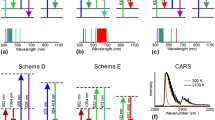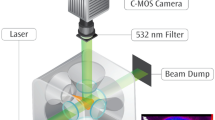Abstract
The strong stimulated Raman scattering (SRS) from diesel fuel droplets has the potential of providing the relative concentration of multicomponent fuel and the absolute size of individual droplets. The morphology-dependent resonances (MDRs) of a sphere cause the droplet to act as an optical resonator which greatly lowers the SRS threshold. The number density, quality factor, and frequency shift of several MDRs are calculated as a function of the ratio of the index of refraction of the liquid and the surrounding gas, which approaches unity at the thermodynamic critical condition for the fuel spray. The SRS spectra of monodispersed droplets of toluene, pentane, Exxon-Aromatic-150, and Mobil D-2 are presented. The exponential growth region of the SRS intensity I 1S as a function of the input laser intensity I input is investigated for the toluene carbon ring breathing mode v 2 and the pentane C-H stretching region. The I 1S ratio of toluene and pentane is measured as a function of the ratio of the toluene and pentane concentration for monodispersed droplets. The reduced fluctuation in I 1S when I input is changed from multimode to single-mode is displayed as a histogram of the I 1S of the v 2 mode of toluene droplets.
Similar content being viewed by others
References
R. Thurn, W. Kiefer: Appl. Opt. 24, 1515 (1985)
T.R. Lettieri, R.E. Preston: Opt. Commun. 54, 349 (1985)
K.H. Fung, I.N. Tang: J. Colloid Interfac. Sci. 130, 219 (1989)
A.C. Eckbreth: Laser Diagnostics for Combustion Temperature and Species (Abacus, Cambridge, Massachusetts 1988) pp. 220–300
S.-X. Qian, J.B. Snow, R.K. Chang: Opt. Lett. 10, 499 (1985)
R.G. Pinnick, A. Biswas, R.L. Armstrong, H. Latifi, E. Creegan, V. Srivastava, G. Fernandez: Opt. Lett. 13, 1099 (1989)
M. Golombok, D.B. Pye: Chem. Phys. Lett. 151, 161 (1988)
M. Golombok, D.B. Pye: J. Phys. D: Appl. Phys. 22, 851 (1989)
S.C. Hill, R.E. Benner: J. Opt. Soc. Am. B 3, 1509 (1986)
P.W. Barber, S.C. Hill: In Optical Particle Sizing: Theory and Practice, ed. by G. Gouesbet, G. Grehan (Plenum, New York 1988) pp. 43–53
S.C. Ching, H.M. Lai, K. Young: J. Opt. Soc. Am. B 4, 1995 (1987)
J.-Z. Zhang, D.H. Leach, R.K. Chang: Opt. Lett. 13, 270 (1988)
D.S. Benincasa, P.W. Barber, J.-Z. Zhang, W.-F. Hsieh, R.K. Chang: Appl. Opt. 26, 1348 (1987)
J.B. Snow, S.-X. Qian, R.K. Chang: Opt. Lett. 10, 37 (1985)
S.-X. Qian, R.K. Chang: Phys. Rev. Lett. 56, 926 (1986)
C.F. Bohren, D.R. Huffman: Absorption and Scattering of Light by Small Particles (Wiley, New York 1983) pp. 93–104
S.C. Hill, R.E. Benner: In Optical Effects Associated with Small Particles, ed. by P.W. Barber, R.K. Chang (World Scientific, Singapore 1988) pp. 3–61
H.A. Haus: Waves and Fields in Optoelectronics (Prentice-Hall, Englewood Cliffs, New Jersey 1984) pp. 201–209
H.M. Lai, P.T. Leung, K. Young: Limitations on Photon Lifetime in Electromagnetic Quasi-Modes in Highly Transparent Microdroplets (to be published)
S.C. Hill, C.K. Rushforth, R.E. Benner, P.R. Conwell: Appl. Opt. 24, 2380 (1985)
P. Chylek: J. Opt. Soc. Am. 66, 285 (1976)
The C-H stretching region of pentane consists of symmetric and asymmetric CH2 and CH3 stretching modes. The data presented are integrated over the entire region. Selecting a single vibrational mode does not significantly improve either the exponential fit in Fig. 5a or the linearity of Fig. 5b but does reduce the signal-to-noise ratio




